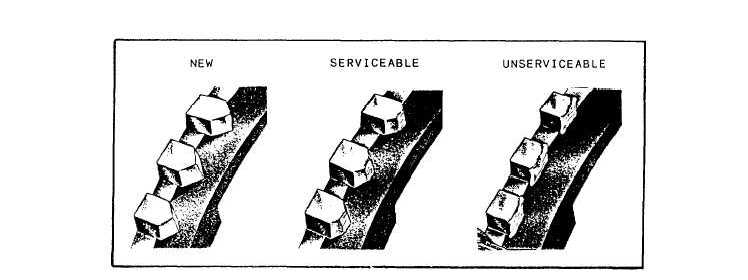Occasionally, a transmission slips out of gear because the driver does not fully engage the gear when moving the lever. However, when a transmission slips out of gear fairly often, it should be replaced.
OVERHAUL OF THE TRANSMISSION
Because of the variations in construction of transmissions, different procedures in the removal, disassembly, repair, assembly, and installation must be followed. These operations generally require from 5 to 7 hours, depending on the procedure followed. If you are working on a vehicle with which you are not familiar, always check the manufacturer's manual.
Before removing the transmission from the vehicle, make sure all accumulations of dirt or road mud are cleaned from the case and the attached parts. Note or mark by scratching the case with a sharp pointed tool, any moist oil spots or unusually heavy accumulations of oil-soaked road mud; these we good clues to the location of small cracks or holes that might escape notice in visual inspection. However, do not confuse these accumulations with those that result from leaking gaskets or oil seals. A leak at a gasket or a seal is more or less normal on a transmission that has been in service for any length of time.
Drain the lubricant from the transmission. Some manufacturers recommend flushing the transmission before removal. This is done by filling the transmission with a flushing oil and operating the engine with the transmission in neutral for several seconds. After this, drain the flushing oil from the transmission.
After removing the transmission case, complete the external cleaning operation with steam-cleaning equipment or by hand brushing the case, using an approved cleaning solvent.
After the transmission is disassembled, make sure all parts are cleaned thoroughly and individually.
Clean away all the parts of hardened oil, lacquer deposits, and dirt, paying particular attention to the small oil holes in the gears and to the lock ball bores in the shifter shaft housing. Remove all gaskets or parts of gaskets using a scraper or other suitable tool. Make sure the metal gasket surfaces are not gouged or scratched.
After all parts of the transmission have been thoroughly cleaned, inspect them to determine whether they can be reused or scrapped. The wear or damage to some of the parts will be evident to the eye, (fig. 11-8) whereas, in others, it may be necessary to use tools or gauges to determine their condition. Since the decision as to whether apart should be scrapped or reused is often a matter of opinion or judgment, you may want to do this job yourself. If you can not do the inspecting yourself, make sure the person doing it is experienced in transmission maintenance and overhaul.
When inspecting transmission parts, bear in mind that the inspection procedure has two objectives; first, to eliminate any part or parts that are unsuitable for use, or doubtful parts that may cause the premature failure of the overhauled transmission; second, and equally important, to reduce the wasteful practice of scrapping parts that still retain a high percentage of useful life.

Figure 11-8. - An example of worn external teeth of a synchronizer clutch.
Continue Reading